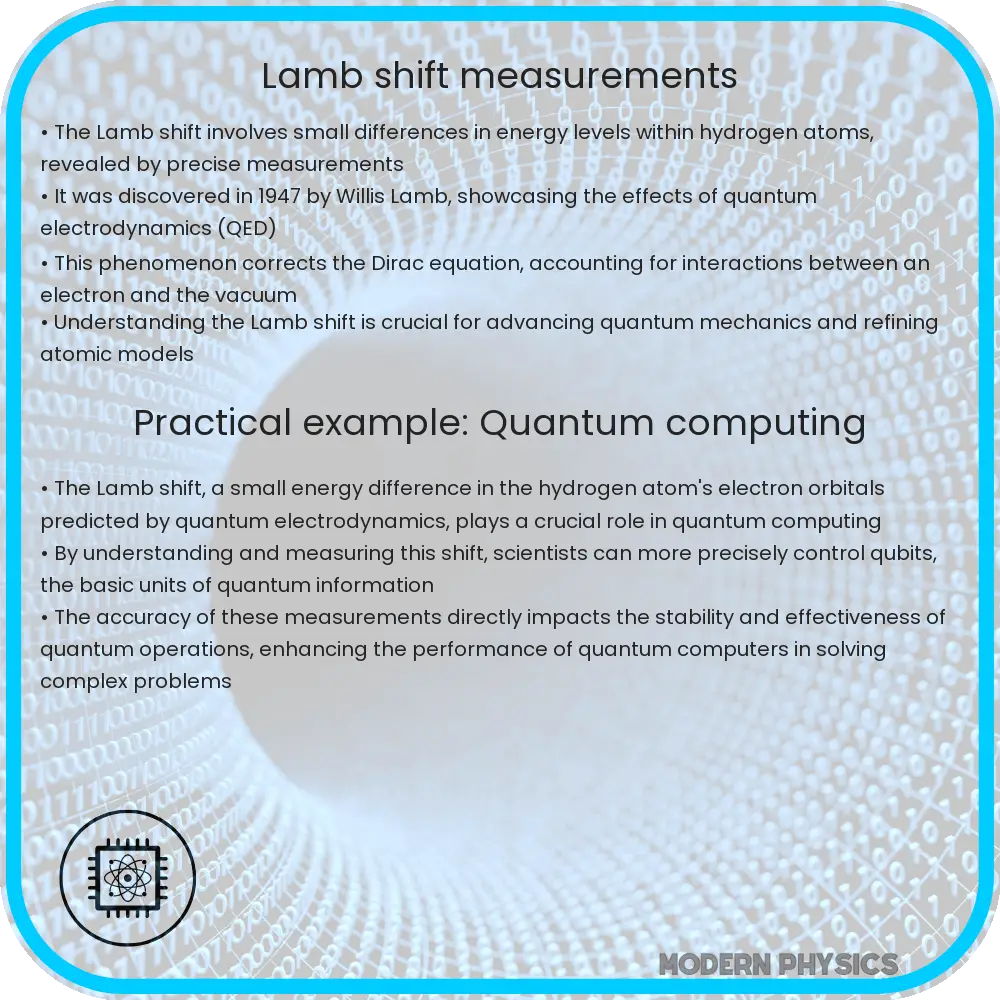Explore the Lamb Shift’s role in quantum physics, its precision measurements, impact on QED, and implications for atomic analysis and technology.

Lamb Shift: Unveiling the Subtleties of Quantum Electrodynamics
The Lamb Shift, a notable phenomenon in the realm of quantum physics, represents a subtle deviation in the energy levels of atomic electrons. Discovered by Willis Lamb and Robert Retherford in 1947, this shift provided crucial evidence for the intricacies of Quantum Electrodynamics (QED) and the interaction of electrons with the vacuum. In this article, we delve into the details of Lamb Shift measurements, their precision, and their implications for QED and atomic analysis.
Understanding the Lamb Shift
At its core, the Lamb Shift pertains to a small difference in energy between two levels of the hydrogen atom: the 2S1/2 and 2P1/2 states. Conventionally, according to Dirac’s theory of the electron, these levels should have the same energy. However, Lamb and Retherford’s experiments revealed a slight discrepancy, measured to be approximately 1057 MHz. This discrepancy, though minute, had profound implications for our understanding of quantum mechanics and the interactions of subatomic particles.
Measuring the Lamb Shift
The measurement of the Lamb Shift is a feat of precision and sophisticated experimental design. Utilizing techniques such as spectroscopy, physicists measure the frequencies of light absorbed or emitted by electrons transitioning between energy levels in hydrogen or hydrogen-like atoms. The accuracy of these measurements has increased dramatically over the years, owing to advances in laser technology and vacuum systems. Modern experiments can measure the Lamb Shift with precisions better than one part in a million, offering deeper insights into the subtle forces at play in atomic structures.
Lamb Shift and Quantum Electrodynamics (QED)
Quantum Electrodynamics, the quantum theory of electromagnetic forces, provides the theoretical framework to understand the Lamb Shift. QED posits that particles such as electrons interact not only with each other but also with virtual particles that spontaneously appear and disappear in the vacuum. These interactions alter the energy levels of electrons in ways that are measurable, as in the case of the Lamb Shift. The precision measurements of the Lamb Shift serve as a rigorous test of QED, validating its predictions to an extraordinary degree of accuracy.
In summary, the study of the Lamb Shift is a cornerstone in the field of quantum physics. Its measurement not only challenges our understanding of atomic structures but also provides a critical test for the theories of QED. The next section will explore the technical nuances of Lamb Shift measurements and their implications in greater detail.
Technical Nuances of Lamb Shift Measurements
To delve deeper into the Lamb Shift measurements, it is essential to consider the technological advancements that have made such precision possible. High-resolution spectroscopy, a primary tool in these measurements, has evolved significantly. Lasers with extremely narrow linewidths allow for the precise determination of the energy levels in hydrogen atoms. Additionally, the development of cryogenic atomic hydrogen masers has provided a stable frequency reference, further enhancing measurement accuracy. These advancements not only aid in Lamb Shift measurements but also contribute to refining the constants of nature, such as the Rydberg constant.
Implications of Lamb Shift in Atomic Analysis
The implications of accurately measuring the Lamb Shift extend beyond validating QED. They play a vital role in atomic physics, particularly in refining our understanding of atomic structures and interactions. For example, the Lamb Shift has implications for the determination of fundamental constants and the testing of theoretical models that go beyond the Standard Model of particle physics. Additionally, these measurements have a direct impact on the precision of atomic clocks and thus, on the fields of global positioning systems and telecommunications.
The Future of Lamb Shift Studies
Looking ahead, the ongoing research in Lamb Shift measurements is steering towards even higher precision and the exploration of similar shifts in heavier atoms, like helium. These studies not only aim to further test the limits of QED but also to explore new physics beyond the current theoretical frameworks. The continual refinement of experimental techniques and the integration of advanced technologies are key to these future endeavors.
Conclusion
In conclusion, the Lamb Shift stands as a pivotal concept in modern physics, bridging the gap between theory and experiment. It underscores the intricate nature of quantum mechanics and the role of virtual particles in shaping the physical universe. The precision measurements of the Lamb Shift have not only substantiated Quantum Electrodynamics but have also facilitated advancements in various technological and scientific domains. As we continue to probe deeper into the quantum world, the Lamb Shift remains a testament to the relentless pursuit of understanding the fundamental forces and particles that constitute our reality. This endeavor, balancing on the edge of theoretical prediction and experimental verification, continues to illuminate the path towards a more comprehensive understanding of the universe.
